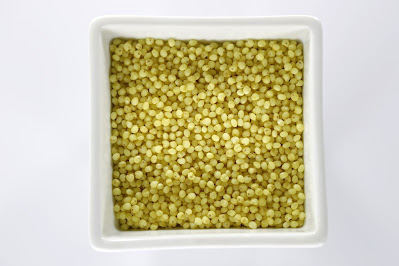Controlling food portions is crucial for weight loss as it helps you manage your calorie intake. Here are some tips to help you control food portions effectively:
Use smaller plates and bowls: Research suggests that people tend to eat more when they use larger plates and bowls. By using smaller dinnerware, you can trick your brain into perceiving larger portions, which can help you feel satisfied with less food.
Measure and weigh your food: Invest in a food scale and measuring cups to accurately measure your food portions. This method ensures you're aware of the exact amount you're consuming. Over time, you'll become better at estimating portion sizes without needing to measure everything.
Follow appropriate serving sizes: Familiarize yourself with appropriate serving sizes for different food groups. Pay attention to recommended serving sizes on nutrition labels. For example, a serving of lean protein like chicken or fish is typically around 3 to 4 ounces, while a serving of grains may be around 1/2 to 1 cup.
Fill half your plate with vegetables: Vegetables are low in calories and high in fiber, which helps you feel full. Make it a habit to fill at least half of your plate with non-starchy vegetables like broccoli, spinach, peppers, or cauliflower. This automatically reduces the space available for higher-calorie foods.
Be mindful of high-calorie foods: While it's important to include a variety of foods in your diet, be aware of calorie-dense foods. These include items like oils, nuts, seeds, cheese, and sweets. Use smaller portions of these high-calorie foods or opt for lower-calorie alternatives.
Pre-portion your meals and snacks: Prepare your meals and snacks in advance and portion them into individual containers. This eliminates the need to estimate serving sizes in the moment and helps prevent overeating. Pre-portioning also makes it easier to grab a healthy snack on the go, avoiding impulse eating.
Slow down and savor your food: Eating slowly and mindfully can enhance your satisfaction and help you recognize when you're full. Chew your food thoroughly, savor the flavors, and pay attention to your body's signals of hunger and fullness. Put your utensils down between bites to give yourself time to register satiety.
Use visual cues for portion control: If you don't have measuring tools available, you can use visual cues to estimate portion sizes. For example, a serving of protein (e.g., meat, fish, tofu) is roughly the size of a deck of cards or the palm of your hand. A serving of grains (e.g., rice, pasta) is about the size of a tennis ball or your clenched fist.
Practice portion control at restaurants: Restaurant portions tend to be larger than what we need. To control portion sizes when dining out, consider sharing a meal with a dining companion, ordering an appetizer as your main course, or asking for a to-go box at the beginning of the meal and putting half of your meal in it to save for later.
Listen to your body's hunger and fullness cues: Pay attention to your body's signals of hunger and fullness. Eat when you're genuinely hungry and stop eating when you feel comfortably satisfied, but not overly full. Avoid mindless snacking or eating out of boredom or emotions.
Remember, portion control is just one aspect of a healthy lifestyle. It's important to focus on balanced nutrition, regular physical activity, and overall well-being to support sustainable weight loss and overall health.
Reduce My Waist | How To Lose Weight | Reduce Belly Fat
Exercises, Diet, Workout and Tips on How to Reduce My Waist, How to Lose Weight, How to Lose Belly Fat, Weight Loss Tips, Belly Fat Diet, Exercises to Lose Belly Fat, Healthy Weight Loss, Reduce Tummy, Waist and Stomach and Waist Slimming Exercises.
Monday, 15 May 2023
How to Control Food Portions for Successful Weight Loss
Monday, 1 May 2023
Health And Weight Loss Benefits Of Proso Millet
Proso millet, also known as broomcorn millet, is a type of cereal grain that has been grown for thousands of years in many parts of the world, including Asia, Europe, and North America. It is a nutritious food that offers several health, weight loss, and fat loss benefits, including:
High in fiber: Proso millet is high in fiber, which can help improve digestion and promote satiety. Consuming high-fiber foods can also help regulate blood sugar levels, reduce cholesterol levels, and lower the risk of heart disease.
Low glycemic index: Proso millet has a low glycemic index, which means that it does not cause a rapid spike in blood sugar levels. This can help regulate blood sugar levels, reduce cravings for sugary or high-carbohydrate foods, and promote weight loss.
Low in fat: Proso millet is low in fat, making it an ideal food for weight loss and fat loss. Consuming low-fat foods can help create a calorie deficit, which is necessary for weight loss.
High in protein: Proso millet is a good source of protein, which is essential for building and repairing tissues in the body. Eating high-protein foods can also help promote satiety, reduce hunger, and preserve muscle mass during weight loss.
Gluten-free: Proso millet is gluten-free, making it an excellent food choice for people with celiac disease or gluten intolerance.
Rich in vitamins and minerals: Proso millet is a good source of several vitamins and minerals, including iron, magnesium, phosphorus, and vitamin B6. These nutrients are essential for maintaining good health and can help boost energy levels and reduce the risk of chronic diseases.
Versatile: Proso millet is a versatile food that can be used in a variety of recipes, including porridges, salads, soups, and stews. This makes it easy to incorporate into a healthy diet.
In summary, proso millet is a nutritious and versatile food that offers several health, weight loss, and fat loss benefits. It is high in fiber, low in fat, and has a low glycemic index, making it an excellent food choice for people looking to lose weight or maintain a healthy diet. It is also a good source of protein, vitamins, and minerals, making it an ideal food for overall health and wellbeing.
Sunday, 23 April 2023
Health And Weight Loss Benefits Of Turmeric
Turmeric is a spice that is commonly used in Indian, Middle Eastern, and Southeast Asian cuisines. It has a deep yellow-orange color and a warm, bitter taste. Turmeric contains a compound called curcumin, which is responsible for its many potential health benefits. Here are some of the potential health benefits of turmeric:
Anti-inflammatory properties: Curcumin is a potent anti-inflammatory compound, which can help reduce inflammation throughout the body.
Antioxidant properties: Turmeric is rich in antioxidants, which can help protect the body against damage from free radicals.
Pain relief: Turmeric has been shown to help relieve pain, particularly in those with osteoarthritis and rheumatoid arthritis.
Improved brain function: Some studies have found that curcumin may improve cognitive function and reduce the risk of Alzheimer's disease.
Lowered risk of heart disease: Curcumin may help lower LDL (bad) cholesterol levels and reduce the risk of heart disease.
Potential weight loss benefits: Some studies have found that turmeric may help promote weight loss by reducing inflammation, improving insulin sensitivity, and increasing metabolism.
Turmeric is a versatile spice that can provide a range of potential health benefits. However, it's important to note that more research is needed to fully understand the extent of these benefits and how they may vary depending on individual health status and other factors. If you are considering using turmeric as a supplement, it's important to talk to your doctor first, especially if you are taking medications or have underlying health conditions.


